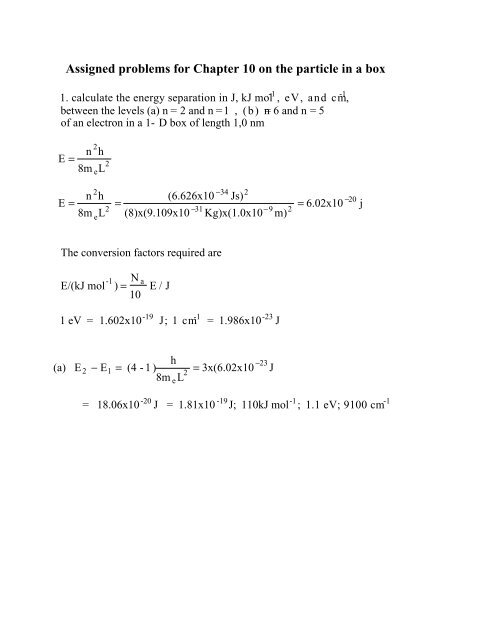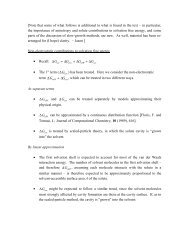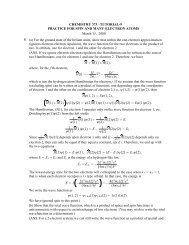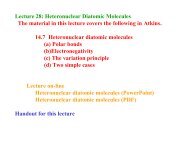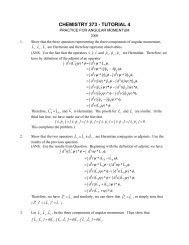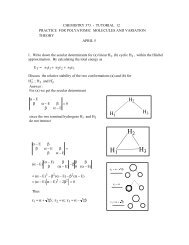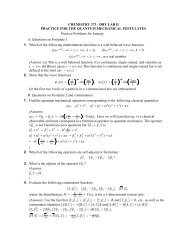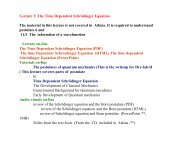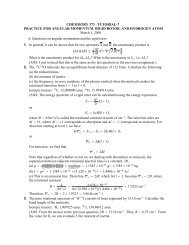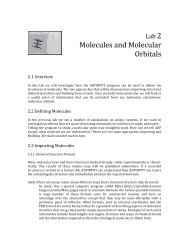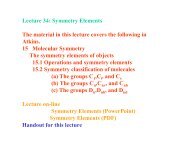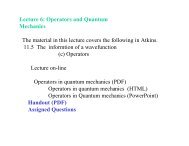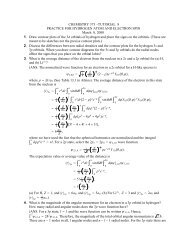Assigned problems for Chapter 10 on the particle in a box - Cobalt
Assigned problems for Chapter 10 on the particle in a box - Cobalt
Assigned problems for Chapter 10 on the particle in a box - Cobalt
You also want an ePaper? Increase the reach of your titles
YUMPU automatically turns print PDFs into web optimized ePapers that Google loves.
2. Calculate <strong>the</strong> probability that a <strong>particle</strong>will be found between 0.49 L and 0.51L <strong>in</strong> a 1 -D<strong>box</strong> of length Lwhen it has (a) n =1, (b) n=2.The <strong>the</strong> wavefuncti<strong>on</strong> to be a c<strong>on</strong>stant <strong>in</strong> this range<strong>the</strong> wavefuncti<strong>on</strong>s aren = 2L s<strong>in</strong> ⎛ n x ⎞⎜ ⎟⎝ L ⎠The propability is0.51LP = ∫ n 2 dx ≈ 2 n x0.49L(a)P = 2 L s<strong>in</strong> 2 ⎛⎜⎝n xLFor x =.5L n=1⎞⎟ x⎠P= 2 L s<strong>in</strong> 2⎛⎞⎜ ⎟ x0.02L = 0.04⎝ 2⎠
3.(a) Write <strong>the</strong> Schröd<strong>in</strong>ger equati<strong>on</strong> <str<strong>on</strong>g>for</str<strong>on</strong>g> a <strong>particle</strong> <strong>in</strong> a 1-D square wellof length L(b) Calculate <strong>the</strong> expectati<strong>on</strong> value of p and p 2 <str<strong>on</strong>g>for</str<strong>on</strong>g> a <strong>particle</strong> <strong>in</strong> <strong>the</strong> state n=1Answ:(a)− h22md 2dx 2= Ewhich has <strong>the</strong> soluti<strong>on</strong>n =2L s<strong>in</strong> ⎛ n x ⎞⎜ ⎟⎝ L ⎠ˆ p = − h iddx< ˆ p >=L∫0n * p ˆn dx = 2hiL 2L ⎛s<strong>in</strong> n x ⎞∫ ⎜ ⎟⎝ L ⎠0ddx s<strong>in</strong> ⎛ n x ⎞⎜ ⎟ dx⎝ L ⎠= 2hiL 2L ⎛s<strong>in</strong> n x ⎞ ⎛∫ ⎜ ⎟ cos n x ⎞⎜ ⎟ dx = 0⎝ L ⎠ ⎝ L ⎠0
4. What are <strong>the</strong> most likely locati<strong>on</strong>s of a <strong>particle</strong> <strong>in</strong> a<strong>box</strong> of length L <strong>in</strong> <strong>the</strong> state n = 3 ?3 = 2L s<strong>in</strong> ⎛ 3 x ⎞⎜ ⎟⎝ L ⎠P(x)∝ 3 3 ∝s<strong>in</strong> 2 ⎛ 3 x⎞⎜ ⎟⎝ L ⎠The maxima and m<strong>in</strong>ima <strong>in</strong> P(x) corresp<strong>on</strong>ds to dP(x)dx = 0dP(x)dx∝ s<strong>in</strong> ⎛ 3 x ⎞ ⎛⎜ ⎟ cos 3 x ⎞ ⎛⎜ ⎟ ∝ s<strong>in</strong> 6 x ⎞⎜ ⎟⎝ L ⎠ ⎝ L ⎠ ⎝ L ⎠⎛s<strong>in</strong> = 0 when = 6 x ⎞⎜ ⎟ = n' , n = 0,1,2.....⎝ L ⎠which corresp<strong>on</strong>ds to x = n' L6, n'< 6.n' = 0,2,4, and 6 corresp<strong>on</strong>ds to m<strong>in</strong>ima <strong>in</strong>n' = 1, 3, and 5 to maxima
5. Set up <strong>the</strong> Schröd<strong>in</strong>ger equati<strong>on</strong> <str<strong>on</strong>g>for</str<strong>on</strong>g> a <strong>particle</strong> of mass m <strong>in</strong> a threedimensi<strong>on</strong>alsquare well withsides L x ;L y ;L z . Show that <strong>the</strong> wavefuncti<strong>on</strong> is def<strong>in</strong>ed by three quantum numbersand that <strong>the</strong> Schröd<strong>in</strong>ger equanti<strong>on</strong> is separable . F<strong>in</strong>d <strong>the</strong> energy levels, and specialize<strong>the</strong> results to a cubic <strong>box</strong> of side LPlease see handout <strong>on</strong> <strong>particle</strong> <strong>in</strong> 3-D <strong>box</strong> (Lecture-<str<strong>on</strong>g>10</str<strong>on</strong>g>)6. To a crude first approximati<strong>on</strong>, a electr<strong>on</strong> <strong>in</strong> a l<strong>in</strong>ear polyenemy be c<strong>on</strong>sidered to be a <strong>particle</strong> <strong>in</strong> a <strong>on</strong>e dimensi<strong>on</strong>al <strong>box</strong>.The polyene - carotene c<strong>on</strong>ta<strong>in</strong>s 22 c<strong>on</strong>jugated C atoms, and <strong>the</strong>average <strong>in</strong>ternuclear distance is 140 pm. Each state up to n =11 isoccupied by two electr<strong>on</strong>s.Calculate(a) <strong>the</strong> separati<strong>on</strong> <strong>in</strong> energy between <strong>the</strong> ground state and<strong>the</strong> first excited state <strong>in</strong> which <strong>on</strong>e electr<strong>on</strong> occupies <strong>the</strong> state with n=12.(b) The frequency of <strong>the</strong> radiati<strong>on</strong> required to produce a transiti<strong>on</strong> between<strong>the</strong>se two states(c) The total probability of f<strong>in</strong>d<strong>in</strong>g an electr<strong>on</strong> between C atoms 11 and 12 <strong>in</strong> <strong>the</strong>groundsate of <strong>the</strong> 22-electr<strong>on</strong> moleculeAnsw:(a): L =(21)x(1.40x<str<strong>on</strong>g>10</str<strong>on</strong>g> -<str<strong>on</strong>g>10</str<strong>on</strong>g> m) = 2.94x<str<strong>on</strong>g>10</str<strong>on</strong>g> −9 m=E = E 12 − E 11 = (2n + 1)x h 22h2= (2x11 + 1)x8mL 8mL 2(23)x(6.626x<str<strong>on</strong>g>10</str<strong>on</strong>g> −34 Js)(8)x(9.11x<str<strong>on</strong>g>10</str<strong>on</strong>g> −31 Kg)x(2.94x<str<strong>on</strong>g>10</str<strong>on</strong>g> −9 ) 2 = 1.603x<str<strong>on</strong>g>10</str<strong>on</strong>g> −19 J = 1.60x<str<strong>on</strong>g>10</str<strong>on</strong>g> −19 J
(b) : = Eh = 1.603x<str<strong>on</strong>g>10</str<strong>on</strong>g>−19 J6.626x<str<strong>on</strong>g>10</str<strong>on</strong>g> −34 Js = 2.42x<str<strong>on</strong>g>10</str<strong>on</strong>g>14 s −1 = 2.42x<str<strong>on</strong>g>10</str<strong>on</strong>g> 14 Hz7. C<strong>on</strong>sider a <strong>particle</strong> <strong>in</strong> a cubic <strong>box</strong>. What is <strong>the</strong> degeneracy of <strong>the</strong> levelsthat has an energy three times that of <strong>the</strong> lowest level.


